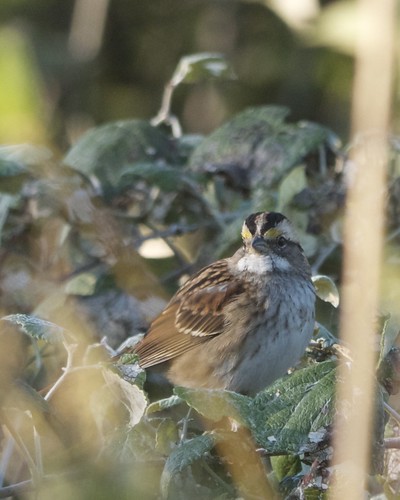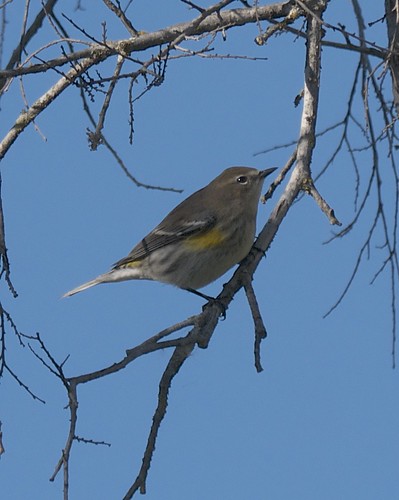Birding my neighborhood Saturday morning last weekend made me so happy. The morning was the coolest we've had so far this season. And there was the best showing of winter bird species yet -- both visually and audibly. Learning the sounds birds make is a huge part of birding. In the winter most birds don't sing, but they still make sounds known as call notes. Many of these call notes are very short, quiet, high-pitched "chip" notes which are usually made to stay in contact with other birds nearby. Even though these chip notes are such subtle sounds, they are often distinctive. You can identify a bird species just by hearing a chip note. Learning them takes time, and learning the winter birds' chip notes is especially challenging because just as you start to recognize them at the end of the winter, the birds leave! You have to re-learn them next fall when the birds return. A few years ago I finally got past this stage, and these days it usually doesn't take me long in late Fall or early Winter to recognize a chip note I haven't heard since last winter.
Saturday morning I birded Lake Creek Trail starting at the Braes Valley end. Right in the parking lot I heard the sharp "pit" chip note of a White-throated Sparrow, a winter resident that likes dense undergrowth in wooded areas. I coaxed it out by playing a recording of its song and got this photo. It's the first one I've seen since last winter.
A little later I heard another first-of-season -- the relatively low-pitched chip note of a Yellow-rumped Warbler.
These birds haven't arrived in force yet, but they are starting to appear in ones and twos, often just flying over. They tend to prefer the middle and upper canopy, often being the higher birds in a mixed-species foraging flock. I heard flyovers three or four times before I finally got a look at one, also my first of the season. Here's a photo of one I got on Sunday morning.
Some other newly returning winter birds I recognized by their calls on Saturday morning were Orange-crowned Warblers (a waxy "chink" note), Song Sparrows (a "chep" or "chirp" low enough to whistle the same note), Lincoln's Sparrows (I can't describe their chip note, but I know it when I hear it), Ruby-crowned Kinglets (typewriter-like "chk, chk-chk"), House Wrens (a variety of fast clattery calls), and a Brown Thrasher. Of all of these birds, I'm least familiar with the thrasher's calls. I had to play a recording of one on my iPhone to verify it. It was a musical "teeroo" followed by one or more fast "smack" sounds. The bird never showed itself.
There's something special about recognizing chip notes. They're very short and quiet, so you have to be paying attention to your ears to even realize you're hearing them. And when you recognize one, the bird species pops into your brain quicker than recognizing longer sounds like bird songs. And it's not like seeing the bird. I know what I'm hearing but I don't see a picture of the bird in my head. Years ago someone who knows Morse Code told me that using it was almost like brain-to-brain communication. The words just appeared in his head as he listened to the short combinations of codes, bypassing vision and spoken language. I wonder if something similar is going on with chip notes.
Hearing so many chip notes, many for the first time since last winter, and having the birds pop into my brain put a big smile on my face. Being out on such a beautiful cool morning made my smile bigger. And having a couple neighbors ask me about birds along the way was icing on the cake. One of them said he appreciated the "work" I'm doing. This ain't work!
Here's my complete species list from Saturday, and here are Saturday's photos.



2 comments:
Agreed. Chip notes are pretty cool, I always give myself a pat on the back when I can correctly ID them..because sometimes it makes me crazzzy!
They can drive me crazy too, but now we have some great tools to help. There's no substitute for time outside listening to the birds and finding them. But nowadays there are smartphone apps with bird sounds categorized as "song", "call", "chip", etc. Having these sounds accessible in the field is great!
Post a Comment